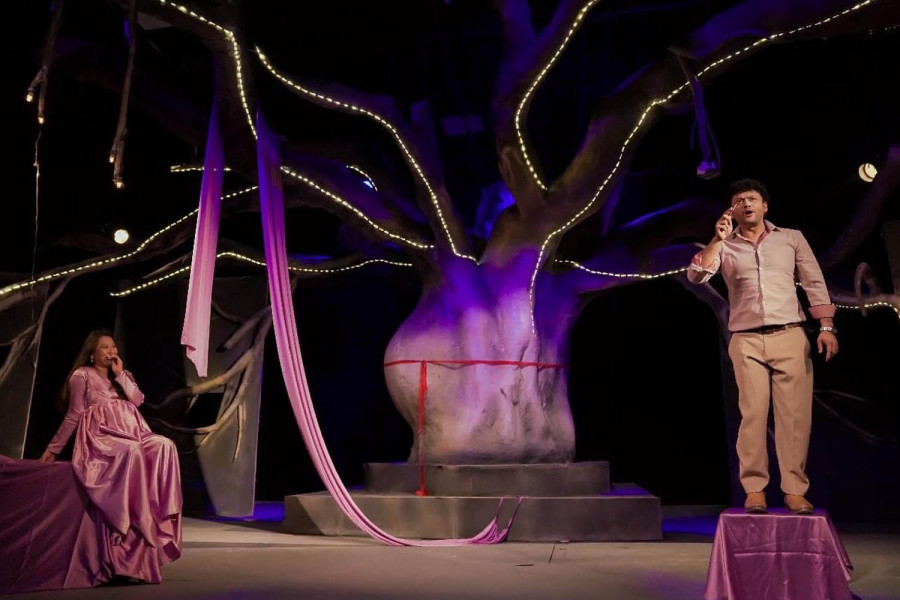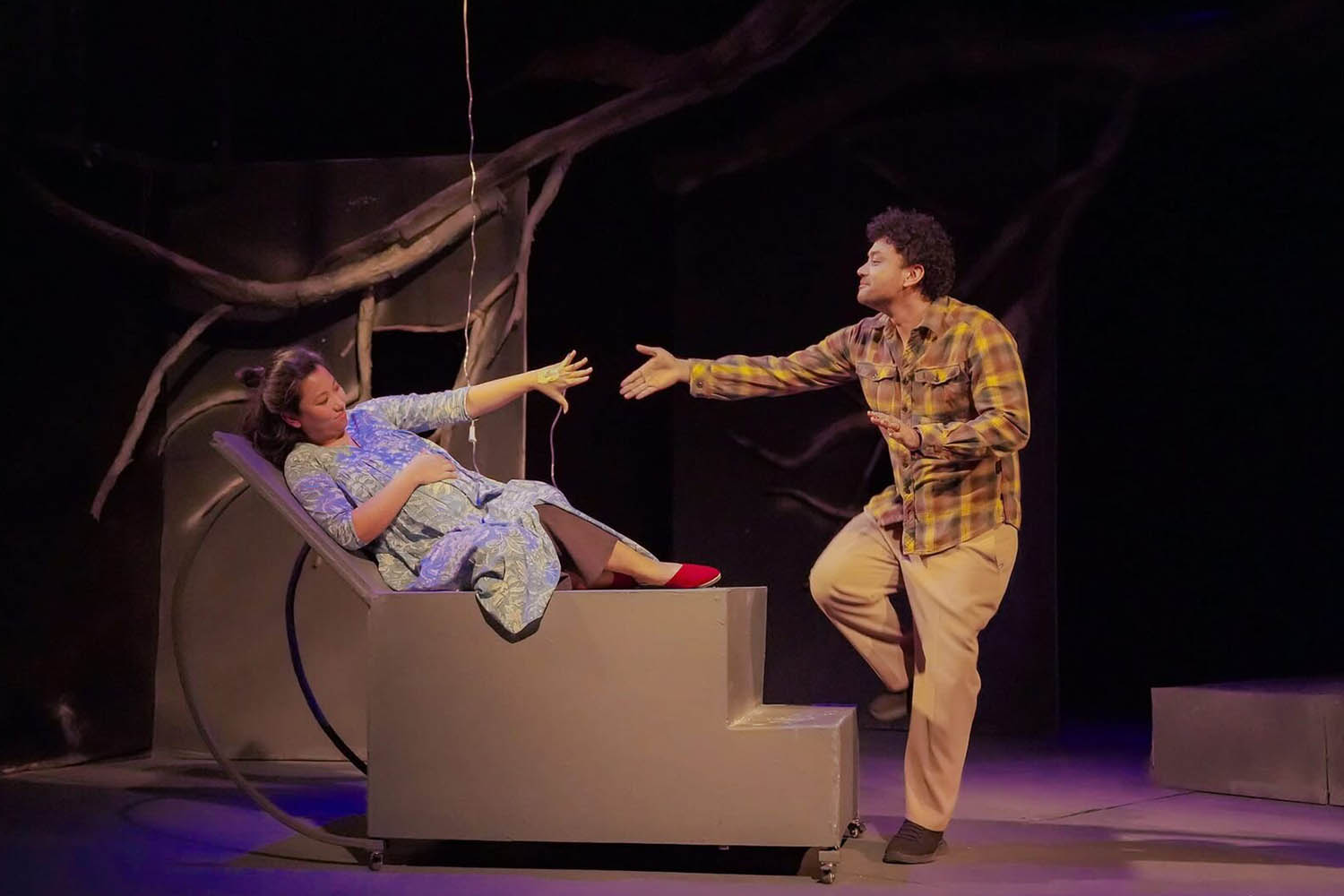Theater
A mother’s heartbeat
Kedar Shrestha’s ‘DhukDhuki 72 Megahertz’ challenges predictable tropes with a layered narrative that explores patriarchy, love, and the complexities of motherhood.
Rishika Dhakal
Having to choose between saving the mother or the child during a complicated pregnancy is a trope adopted by many movies and plays as their narrative crux. Adopting such tropes simplifies the plot, adding nothing but predictable melodrama.
Directed by Kedar Shrestha and produced by Dayahang Rai, the play ‘DhukDhuki 72 Megahertz’ revolves around the same theme. However, its layered narrative breaks free from cliched storytelling.
The play opens with the wife (Menuka Pradhan) caressing her baby bump. Her husband (Karma) enters the stage, and affectionate banter follows. The couple shares their views on life, patriarchy, motherhood, and love.
As the conversation unfolds to its depth, the audience learns that the wife is a teacher interested in writing poetry, while the husband is an artist by profession.
During their conversation, the actors explore ongoing yet concealed discourses about patriarchy. This dismantles the belief that men alone are the enforcers of patriarchy. It highlights how patriarchal settings influence women to think and act in a patriarchal way, manifesting in their behaviour and beliefs.
As the play progresses, lighting stands out as a powerful tool. It complements the depth of the dialogues, which are rich in literature and philosophy. One dialogue, “To understand light, one must first experience darkness,” is accompanied by the husband lighting the dim stage. This lighting shift shows the synchrony between the stage setting and the dialogues.
In one scene, the couple is preparing for a maternity photoshoot. The husband teases his wife, questioning the ideologies she once subscribed to. The wife says with conviction, “The heart has defeated the mind. I want to experience the full essence of motherhood.”
Her dialogue reflects the inner complexities of human beings, which are as sublime as a river. This scene taps into human beings’ raw and unfiltered nature, which is untainted and untouched by the weight of any ideological grandeur.
Through the exchange of dialogues between the wife and the husband, the writer of this play is also seen to be critiquing the audience’s tendency to seek definitive interpretations of art instead of trusting their understanding. This is evident when the husband complains to his wife about a visitor at his art exhibition, who keeps hurling questions at him about his artwork.
This scene reminded me of the time when I watched the movie ‘Shambhala’. After the film’s end, a viewer asked the cast what happened at the end, hinting at a need for closure rather than relying on their interpretation of the film.
As the couple prepares for their photoshoot, the husband kisses his wife’s baby bump, saying, “Even husbands have some elements of motherhood in them.” This scene scored laughter from the audience. Through this scene, the director was clever enough to satirise such men who contribute little at home yet consider themselves paragons of balance between work and family.
As the play progresses to its main plot, the wife is admitted to the hospital. The husband receives devastating news about complications in his wife’s pregnancy. The play now deals with a difficult juncture: is the baby to be saved or the mother?
The wife decides to save the baby. Next, the duo argue, during which the husband questions her willingness to leave him behind. However, the wife firmly defends her agency, asserting her right to decide for her body.

After this scene, the extensive cries and wallows may lead one to perceive the play as celebrating women asserting their rights. However, the true beauty of the play lies in its refusal to glorify any particular theme. Instead, it presents the reality of individuals navigating their ideologies and emotions.
The wife epitomises the idea that ‘you cannot philosophise your way out of a traffic jam,’ which means that one’s feelings and innate experiences shape and dictate the paths for us to walk on.
The long pauses taken by the cast amplify the essence of the play, allowing them to immerse themselves in the emotions they convey on stage. For instance, after putting on a brave face about the complications of the pregnancy in front of his wife, the husband breaks down alone in the hospital. This scene acts as a cathartic release, both for the character and the audience.
The stage design remains consistent throughout the play, with elements creatively adapted to serve multiple purposes. A prominent feature is the tree in the middle of the stage. It acts as a symbol of many things. Initially, the tree represents nature and serves as a space where the wife and the husband share their deepest feelings. Similarly, the picture of the baby in the womb is projected in the tree, depicting the natural essence of childbirth. In grief, the wife always goes near the tree and converses with herself. Her inclination towards the tree reflects her need for connection to the natural world.
Likewise, both characters' conversation about love takes the form of a tough love talk. During one exchange, the wife defines love as “Something to be felt, and that feeling is never going to be lost.” This subjectifies the definition of love. In this way, the play has tried to give meaning to the undefined emotion of love.
The play's thematic resonance occurs when the audience is made to see the vision seen by the wife. In her vision, the wife hears her baby speaking to her while still in the womb. When she asks how the child can speak, the child explains that it can communicate and feel everything the mother feels through the umbilical cord.
This connection is akin to a radio—when plugged in, it plays music. The radio serves a recurring role throughout the play, with a love song by Kumar Sanu being played. Just as the radio connects to the music, the umbilical cord connects the mother and child, much like the baby’s voice, which can be seen as a love song for the mother.
This is where the concept of ‘DhukDhuki’ ties in. For many, hearing Kumar Sanu’s love song makes their DhukDhuki (heartbeat) rise. For mothers, hearing their baby’s voice is their true ‘DhukDhuki’, a heartbeat of love and connection.
The wife talks about how ‘DhukDhuki’ is a metaphor for life’s continuity. For her, the DhukDhuki symbolises the growing baby inside her, once again reflecting the natural process of life. In this sense, the baby represents nature’s everlasting cycle, and the love the wife has for her child symbolises the importance of love, highlighting how essential love is in an individual's life.
The play, which runs for 90 minutes with just two actors, is an exemplary display of artistry. The actor’s ability to laugh and cry convincingly on stage deserves commendation.
The story suits anyone looking to forget societal norms and expectations and immerse themselves in a deeply cathartic experience.
DhukDhuki 72 Megahertz
Director: Kedar Shrestha
Cast: Menuka Pradhan, Karma
Where: Mandala Theatre, Thapagaun, Kathmandu
Showtimes: Every day at 5:30 pm (except Monday) and an extra 1:00 pm show on Saturday until December 1.




 15.47°C Kathmandu
15.47°C Kathmandu











